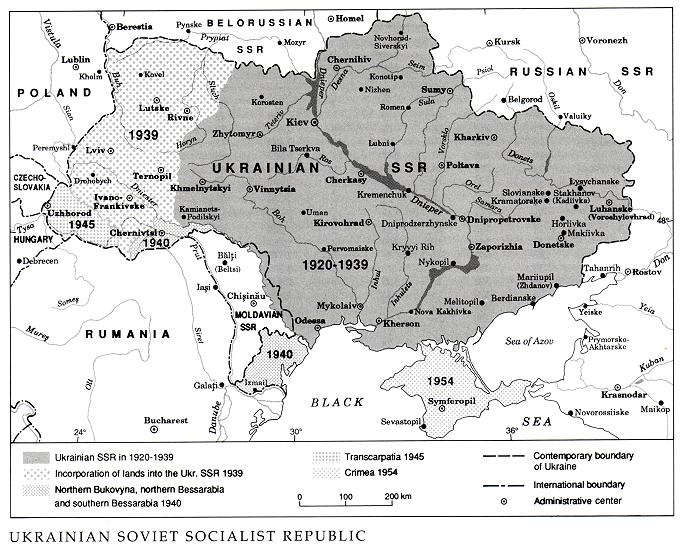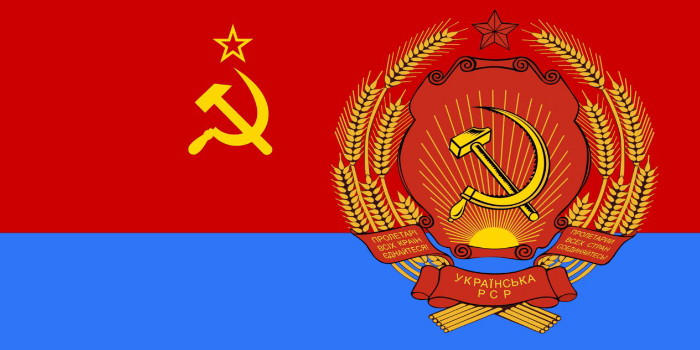Ukrainian Soviet Socialist Republic
Ukrainian Soviet Socialist Republic [Українська Радянська Соціялістична Республіка; Ukrainska Radianska Sotsialistychna Respublika, or УРСР; URSR; Ukrainian SSR]. A communist state proclaimed by the First All-Ukrainian Congress of Soviets in Kharkiv on 24–25 December 1917 and established through armed aggression against the Ukrainian National Republic by Soviet Russia and local Bolshevik forces in 1917–20 (see Ukrainian-Soviet War, 1917–21). At the end of 1922 it became one of the constituent republics of the Union of Soviet Socialist Republics. Until 1937 it was called the Ukrainian Socialist Soviet Republic (; Ukrainska Sotsialistychna Radianska Respublika). The Ukrainian SSR ceased to exist on 24 August 1991, when the Supreme Soviet of the Ukrainian SSR proclaimed the independent state of Ukraine.
The Ukrainian SSR bordered on the Black Sea and the Sea of Azov in the south, on Romania, the Moldavian Soviet Socialist Republic, and Hungary in the southwest, on Czechoslovakia and Poland in the west, on the Belorussian Soviet Socialist Republic in the north, and on the Russian Soviet Federated Socialist Republic in the northeast and east. The total length of its borders was 6,466 km, of which 4,142 km were with other USSR republics, 1,271 km were with Eastern European countries, and the remaining 1,053 km were coast. Lying between 52°10ʹ and 40°23ʹ N latitude (893 km from north to south) and between 22°10ʹ and 40°15ʹ E longitude (1,316 km from west to east), the Ukrainian SSR had an area of 603,700 sq km. It was the third-largest USSR republic, after the RSFSR and the Kazakh Soviet Socialist Republic.
The population of the Ukrainian SSR, second only to that of the RSFSR, was 51.7 million according to the 1989 census; 34.6 million, or 67 percent of it, was urban. Less than three-quarters of the population was Ukrainian (72.7 percent), over one-fifth was Russian (22.1 percent), and other national minorities accounted for the remaining 5.2 percent (including 0.95 percent Jews, 0.86 percent Belarusians, 0.63 percent Moldavians, 0.45 percent Bulgarians, 0.43 percent Poles, 0.32 percent Hungarians, 0.26 percent Romanians, 0.19 percent Greeks, and 0.17 percent Crimean Tatars). For administrative purposes the Ukrainian SSR was divided into 25 oblasts, 479 raions, and 8,878 rural councils (silrady). Of its 434 cities 2 were subordinated directly to the republican government, 142 to the oblast governments, and 290 to the raion authorities. There were 927 urban-type settlements in 1989 (see the table). The borders of the Ukrainian SSR did not encompass the entire Ukrainian ethnic territory, which is one-quarter larger (750,200 sq km) than the national territory and contains 16 percent more people (60 million). The capital of the Ukrainian SSR was Kharkiv, and from 1934, Kyiv.
Political structure. During the revolutionary period the Bolsheviks set up, on 25 December 1917, the Central Executive Committee of the Soviets of Ukraine as the government of Soviet Ukraine and formed, on 17 December, the People's Secretariat (headed by Yukhym Medvediev and then Mykola Skrypnyk). The Bolsheviks had proclaimed Ukraine a republic of workers’, soldiers’, and peasants’ soviets federated closely with Soviet Russia. Yet the Constitution of the Ukrainian Soviet Socialist Republic of 10 March 1919 did not mention any federative links, and established a nominally independent state. In reality Moscow (the Party and government of Soviet Russia) controlled the Ukrainian SSR through the Communist Party of Ukraine, which, except briefly, from the Tahanrih Bolshevik Conference in April to its first congress in Moscow in July 1918, was a constituent part of the Russian Communist Party (Bolshevik) (see Communist Party of the Soviet Union).
The government institutions of the Ukrainian SSR were copies of the Russian institutions, and Ukrainian legislation merely echoed Russian laws. In fact, Russia’s legislative acts were enforced automatically in Ukraine. The pretense of a separate Ukrainian state was maintained briefly to counteract the appeal of the Ukrainian National Republic among the Ukrainian people. As soon as Soviet rule was established firmly in Ukraine, the Ukrainian SSR was turned into a constituent part of the federated state of the USSR.
In 1917–27 the highest governing body of Soviet Ukraine was the All-Ukrainian Congress of Soviets. That body elected the All-Ukrainian Central Executive Committee, which governed the country between sessions of the congress and appointed the Council of People's Commissars as its executive organ. Similar bodies were established locally on the city, village, volost, county, and gubernia level. Their members were selected through indirect elections, in which a worker’s vote was worth more than a peasant’s, and some citizens had no vote at all.
The Ukrainian SSR was absorbed into the RSFSR by the merging of their commissariats on the basis of so-called defensive or economic alliance treaties between two or more Soviet republics (1 June 1919 and 28 December 1920). The situation did not change when the Ukrainian SSR joined the USSR on 30 December 1922 as an equal partner of the RSFSR, the Belorussian SSR and the Transcaucasian SFSR. In the revised (May 1925) Constitution of the Ukrainian Soviet Socialist Republic and its new version (1929) the governing bodies remained similar to the previous ones: the All-Ukrainian Congress of Soviets, the All-Ukrainian Central Executive Committee (headed by Hryhorii Petrovsky), and the Council of People's Commissars (headed by Vlas Chubar and later by Panas Liubchenko). The organs of the state administration, the people's commissariats, were of three types: (1) merged, which existed at the USSR level and had representatives in the republican governments; (2) joint, which existed in parallel at both the USSR and the republican levels; and (3) independent, which existed only at the republican level. In the Union agreement, five merged commissariats were created: foreign affairs, defense, foreign trade, transportation, and postal and telegraph service. Later, other commissariats were also merged. The new constitutions of the USSR (1936) and the Ukrainian SSR (1937) centralized the government system even further. A system of direct elections was introduced, and every citizen was given the vote. The Supreme Soviet of the Ukrainian SSR, with its Presidium, became the highest governing body, and the Council of People's Commissars (from 1946, the Council of Ministers of the Ukrainian SSR) became the highest executive organ. The people's commissariats were classified into (1) all-Union, (2) Union-republican, and (3) republican, and the number of all-Union and Union-republican commissariats was increased. The Constitution of 1 February 1944 gave the Ukrainian SSR new powers in foreign relations and defense by establishing Union-republican commissariats (later ministries) in those areas. The Ukrainian SSR did not establish its own embassies or armed forces, however. By the end of the 1940s Ukraine’s Ministry of Defense had been abolished.
As the rights of the Union republics were expanded after Joseph Stalin’s death, the Ukrainian SSR received in its revised constitution some new powers in administrative, judicial, and economic matters. In 1957, regional economic councils were introduced in addition to the republican economic councils to strengthen republican autonomy. The Ukrainian SSR gained the right to pass its own laws in the field as long as they were consistent with Union legislation and were called for by Union organs. On that basis a number of new Ukrainian SSR codes were worked out in the 1950s and 1960s. From the end of the 1960s the system of government was increasingly centralized: by 1978 there were 28 Union-republican ministries and 16 state committees, and only 6 republican ministries. As of June 1986 there were 23 Union-republican ministries and 14 state committees, and 6 republican ministries and 1 republican state committee. The last Constitution of the Ukrainian Soviet Socialist Republic (1978), modeled on the USSR constitution (1977), reiterated the main articles of the latter and made only minor changes in the structure of government. Structural changes in the ministries could be made thenceforth by legislative enactment.
Both formally and actually the Ukrainian SSR was a unitary state without autonomous parts. Until 1940 it contained the Moldavian Autonomous Soviet Socialist Republic, which that year became a separate Union republic. In 1954 Crimea oblast was transferred from the RSFSR to the Ukrainian SSR. After a local referendum in January 1991, the Supreme Soviet of the Ukrainian SSR recognized the Crimea’s autonomy. Until the end of 1991 the Ukrainian SSR was part of a broader federation of the USSR and its governing organs were subordinated to the governing organs of the USSR. Until 1990 the leading force in the political system in the Ukrainian SSR was the Communist Party of Ukraine, which was merely a branch of the Communist Party of the Soviet Union.
(For the history of the Ukrainian SSR see History of Ukraine. See also International legal status of Ukraine.)
BIBLIOGRAPHY
Fedenko, P. Ukraïna pislia smerty Stalina (Munich 1956)
Zlenko, A. Derzhavnyi ustrii Ukraïns’koï RSR (Kyiv 1959)
Sullivant, R. Soviet Politics and the Ukraine, 1917–1957 (New York 1962)
Bilinsky, Y. The Second Soviet Republic: The Ukraine after World War II (New Brunswick, NJ 1964)
Lewytzkyj, B. Die Sowjetukraine, 1944–1963 (Köln–Berlin 1964)
Potichnyj, P. (ed). Ukraine in the Seventies (Oakville, Ont 1975)
Krawchenko, B. (ed). Ukraine after Shelest (Edmonton 1983)
Lewytzkyj, B. Politics and Society in Soviet Ukraine, 1953–1980 (Edmonton 1984)
Istoriia gosudarstva i prava Ukrainskoi SSR, 3 vols (Kyiv 1987–)
Marples, D. Ukraine under Perestroika (Edmonton 1991)
Solchanyk, R. (ed). Ukraine: From Chernobyl’ to Sovereignty (Edmonton 1992)
Kuzio, T. Ukraine: Perestroika to Independence, (Edmonton 1994; 2nd edn New York 2000)
Vasyl Markus, Ihor Stebelsky
[This article originally appeared in the Encyclopedia of Ukraine, vol. 5 (1993).]


